University Research: The Effect of Motivation on Employee Performance
VerifiedAdded on 2020/03/07
|52
|12439
|830
Project
AI Summary
This project dissertation investigates the impact of motivation on employee performance, focusing on a case study of Marks & Spencer. The research explores the relationship between motivational strategies and employee output, analyzing various factors like skill levels, tangible and intangible benefits, and the limitations of motivation. The study employs thematic analysis of secondary data, including journals and articles, to evaluate the effectiveness of different motivational approaches. It addresses research objectives such as evaluating the impact of motivational strategies, analyzing the significance of employee motivation on organizational performance, and recommending suitable strategies for Marks & Spencer. The dissertation includes a literature review covering motivation theories, employee performance articles, Maslow's hierarchy of needs, and a detailed research methodology outlining the research philosophy, approach, data collection, and analysis methods. The findings and analysis section evaluates the impact of motivational strategies and the significance of employee motivation on organizational performance, culminating in conclusions and recommendations for Marks & Spencer. The study acknowledges limitations such as time constraints and the lack of comparative analysis with other companies, while highlighting the importance of employee motivation in driving organizational success.
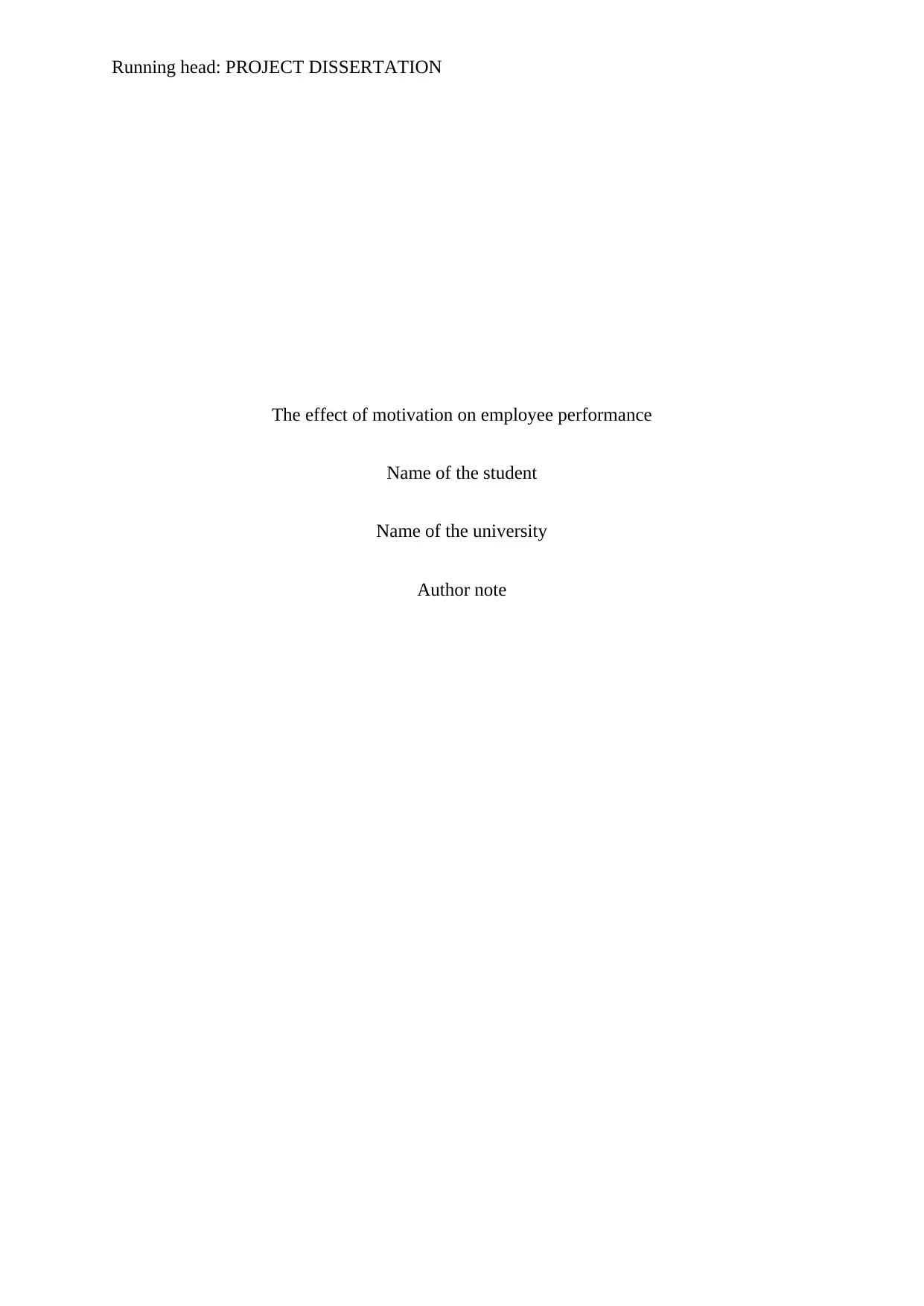
Running head: PROJECT DISSERTATION
The effect of motivation on employee performance
Name of the student
Name of the university
Author note
The effect of motivation on employee performance
Name of the student
Name of the university
Author note
Paraphrase This Document
Need a fresh take? Get an instant paraphrase of this document with our AI Paraphraser
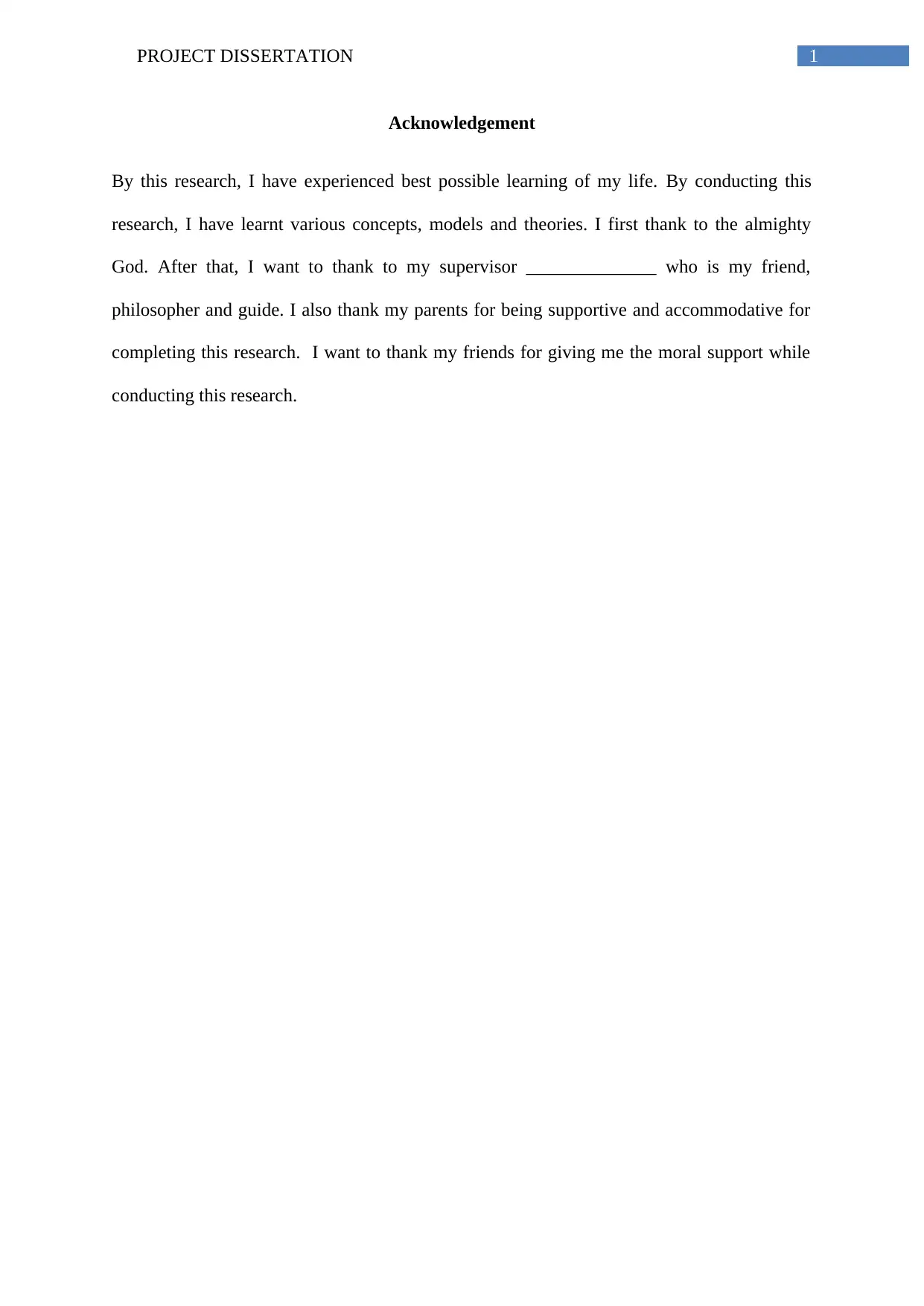
1PROJECT DISSERTATION
Acknowledgement
By this research, I have experienced best possible learning of my life. By conducting this
research, I have learnt various concepts, models and theories. I first thank to the almighty
God. After that, I want to thank to my supervisor ______________ who is my friend,
philosopher and guide. I also thank my parents for being supportive and accommodative for
completing this research. I want to thank my friends for giving me the moral support while
conducting this research.
Acknowledgement
By this research, I have experienced best possible learning of my life. By conducting this
research, I have learnt various concepts, models and theories. I first thank to the almighty
God. After that, I want to thank to my supervisor ______________ who is my friend,
philosopher and guide. I also thank my parents for being supportive and accommodative for
completing this research. I want to thank my friends for giving me the moral support while
conducting this research.
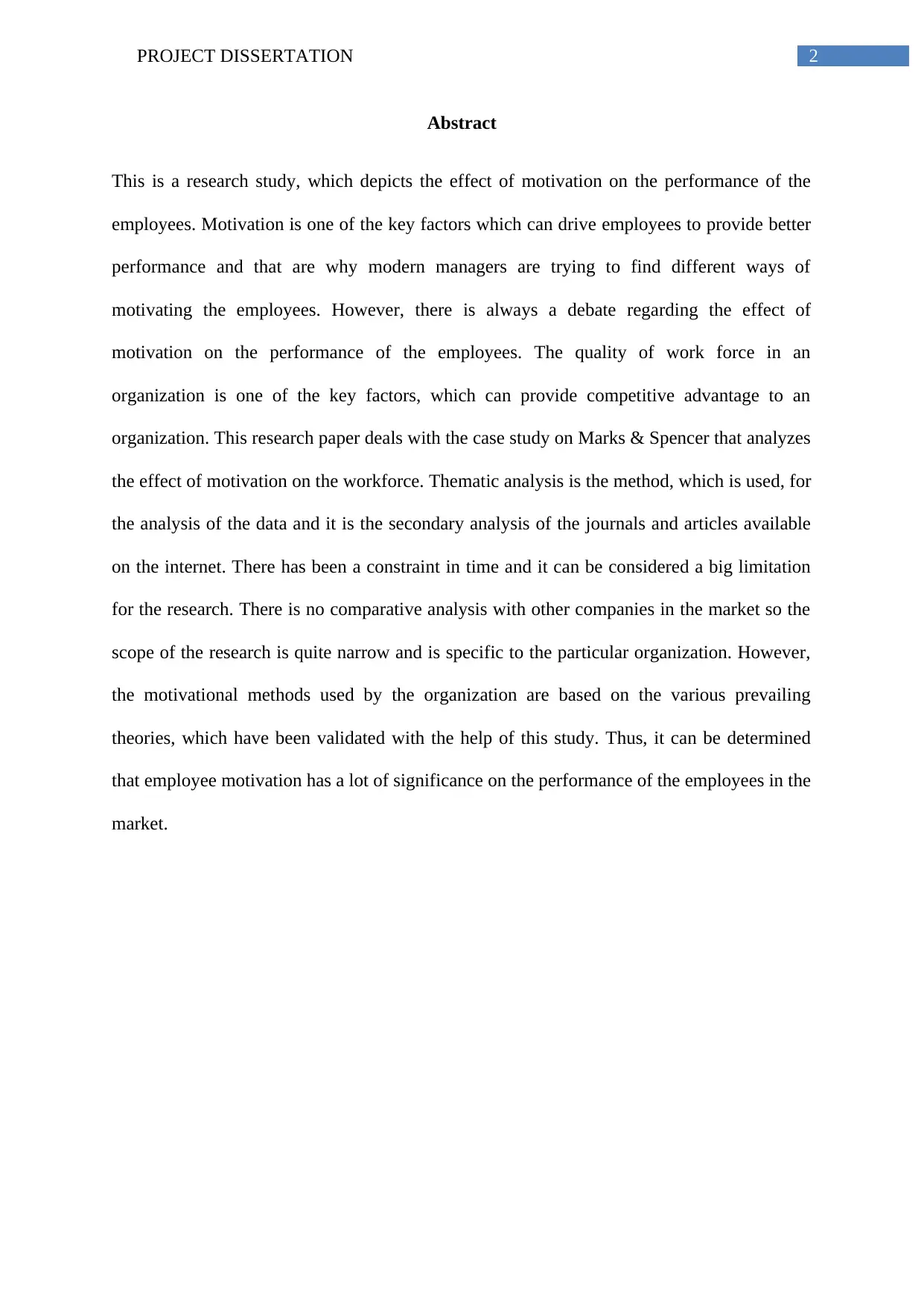
2PROJECT DISSERTATION
Abstract
This is a research study, which depicts the effect of motivation on the performance of the
employees. Motivation is one of the key factors which can drive employees to provide better
performance and that are why modern managers are trying to find different ways of
motivating the employees. However, there is always a debate regarding the effect of
motivation on the performance of the employees. The quality of work force in an
organization is one of the key factors, which can provide competitive advantage to an
organization. This research paper deals with the case study on Marks & Spencer that analyzes
the effect of motivation on the workforce. Thematic analysis is the method, which is used, for
the analysis of the data and it is the secondary analysis of the journals and articles available
on the internet. There has been a constraint in time and it can be considered a big limitation
for the research. There is no comparative analysis with other companies in the market so the
scope of the research is quite narrow and is specific to the particular organization. However,
the motivational methods used by the organization are based on the various prevailing
theories, which have been validated with the help of this study. Thus, it can be determined
that employee motivation has a lot of significance on the performance of the employees in the
market.
Abstract
This is a research study, which depicts the effect of motivation on the performance of the
employees. Motivation is one of the key factors which can drive employees to provide better
performance and that are why modern managers are trying to find different ways of
motivating the employees. However, there is always a debate regarding the effect of
motivation on the performance of the employees. The quality of work force in an
organization is one of the key factors, which can provide competitive advantage to an
organization. This research paper deals with the case study on Marks & Spencer that analyzes
the effect of motivation on the workforce. Thematic analysis is the method, which is used, for
the analysis of the data and it is the secondary analysis of the journals and articles available
on the internet. There has been a constraint in time and it can be considered a big limitation
for the research. There is no comparative analysis with other companies in the market so the
scope of the research is quite narrow and is specific to the particular organization. However,
the motivational methods used by the organization are based on the various prevailing
theories, which have been validated with the help of this study. Thus, it can be determined
that employee motivation has a lot of significance on the performance of the employees in the
market.
⊘ This is a preview!⊘
Do you want full access?
Subscribe today to unlock all pages.

Trusted by 1+ million students worldwide
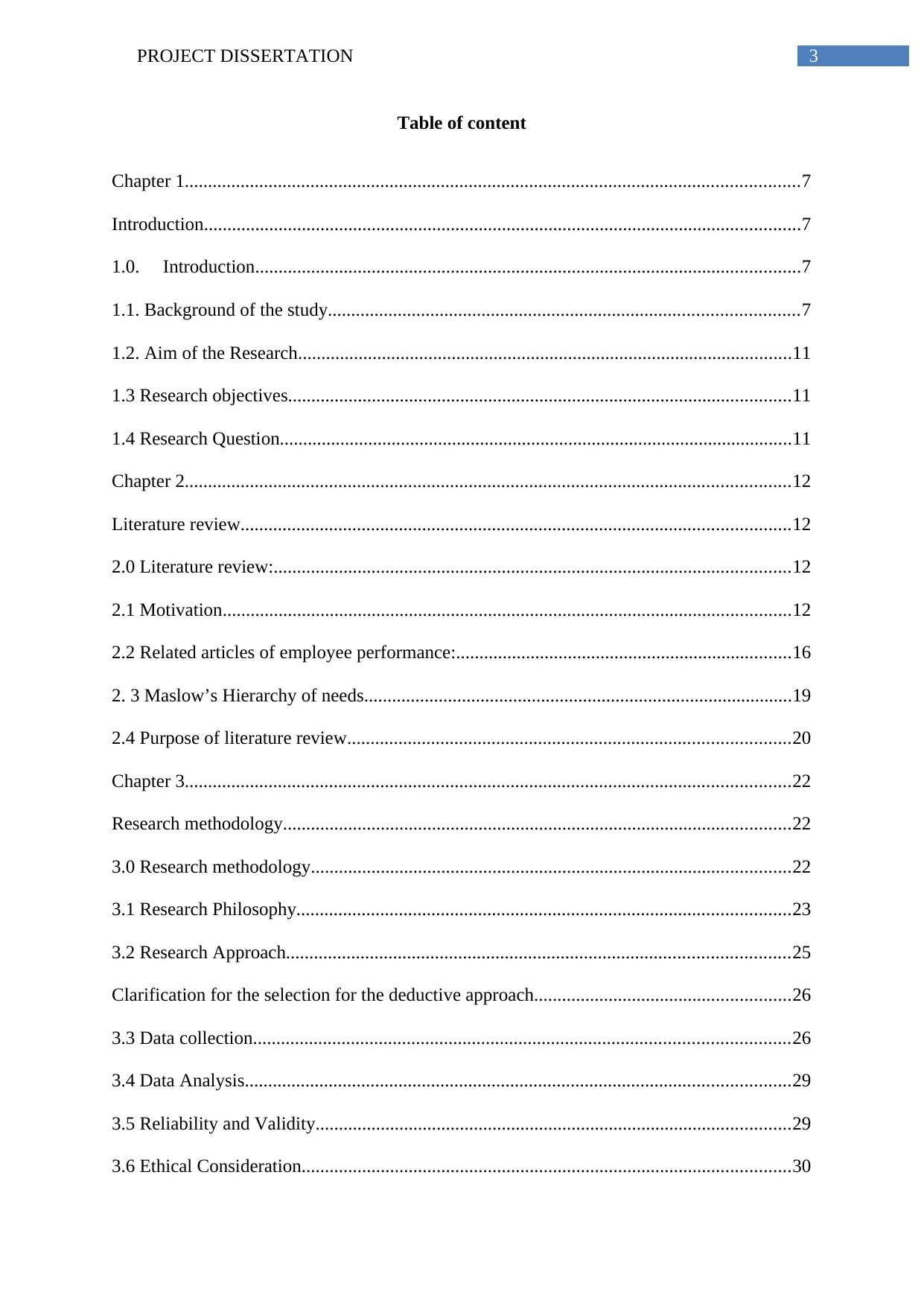
3PROJECT DISSERTATION
Table of content
Chapter 1....................................................................................................................................7
Introduction................................................................................................................................7
1.0. Introduction.....................................................................................................................7
1.1. Background of the study.....................................................................................................7
1.2. Aim of the Research..........................................................................................................11
1.3 Research objectives............................................................................................................11
1.4 Research Question..............................................................................................................11
Chapter 2..................................................................................................................................12
Literature review......................................................................................................................12
2.0 Literature review:...............................................................................................................12
2.1 Motivation..........................................................................................................................12
2.2 Related articles of employee performance:........................................................................16
2. 3 Maslow’s Hierarchy of needs............................................................................................19
2.4 Purpose of literature review...............................................................................................20
Chapter 3..................................................................................................................................22
Research methodology.............................................................................................................22
3.0 Research methodology.......................................................................................................22
3.1 Research Philosophy..........................................................................................................23
3.2 Research Approach............................................................................................................25
Clarification for the selection for the deductive approach.......................................................26
3.3 Data collection...................................................................................................................26
3.4 Data Analysis.....................................................................................................................29
3.5 Reliability and Validity......................................................................................................29
3.6 Ethical Consideration.........................................................................................................30
Table of content
Chapter 1....................................................................................................................................7
Introduction................................................................................................................................7
1.0. Introduction.....................................................................................................................7
1.1. Background of the study.....................................................................................................7
1.2. Aim of the Research..........................................................................................................11
1.3 Research objectives............................................................................................................11
1.4 Research Question..............................................................................................................11
Chapter 2..................................................................................................................................12
Literature review......................................................................................................................12
2.0 Literature review:...............................................................................................................12
2.1 Motivation..........................................................................................................................12
2.2 Related articles of employee performance:........................................................................16
2. 3 Maslow’s Hierarchy of needs............................................................................................19
2.4 Purpose of literature review...............................................................................................20
Chapter 3..................................................................................................................................22
Research methodology.............................................................................................................22
3.0 Research methodology.......................................................................................................22
3.1 Research Philosophy..........................................................................................................23
3.2 Research Approach............................................................................................................25
Clarification for the selection for the deductive approach.......................................................26
3.3 Data collection...................................................................................................................26
3.4 Data Analysis.....................................................................................................................29
3.5 Reliability and Validity......................................................................................................29
3.6 Ethical Consideration.........................................................................................................30
Paraphrase This Document
Need a fresh take? Get an instant paraphrase of this document with our AI Paraphraser
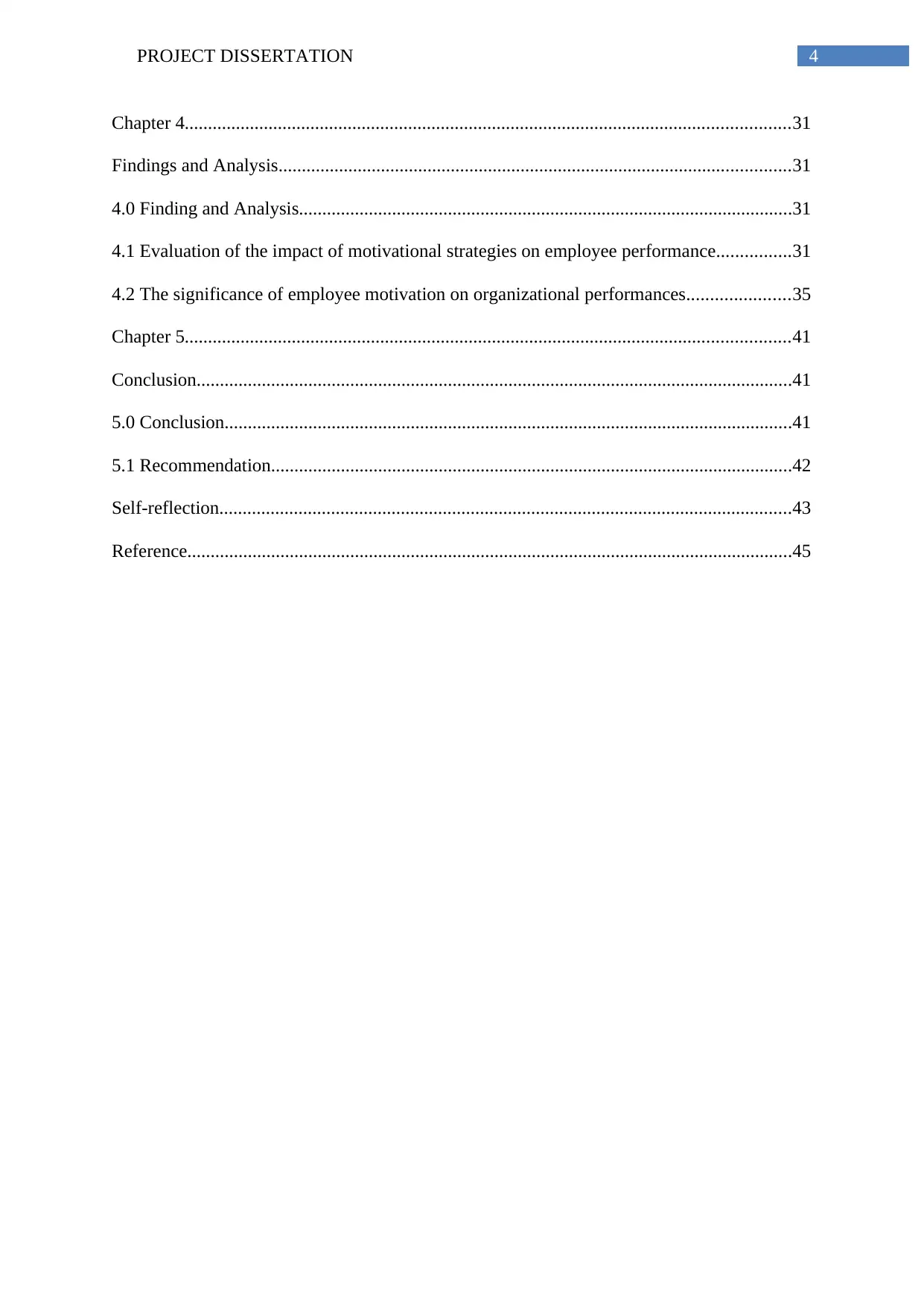
4PROJECT DISSERTATION
Chapter 4..................................................................................................................................31
Findings and Analysis..............................................................................................................31
4.0 Finding and Analysis..........................................................................................................31
4.1 Evaluation of the impact of motivational strategies on employee performance................31
4.2 The significance of employee motivation on organizational performances......................35
Chapter 5..................................................................................................................................41
Conclusion................................................................................................................................41
5.0 Conclusion..........................................................................................................................41
5.1 Recommendation................................................................................................................42
Self-reflection...........................................................................................................................43
Reference..................................................................................................................................45
Chapter 4..................................................................................................................................31
Findings and Analysis..............................................................................................................31
4.0 Finding and Analysis..........................................................................................................31
4.1 Evaluation of the impact of motivational strategies on employee performance................31
4.2 The significance of employee motivation on organizational performances......................35
Chapter 5..................................................................................................................................41
Conclusion................................................................................................................................41
5.0 Conclusion..........................................................................................................................41
5.1 Recommendation................................................................................................................42
Self-reflection...........................................................................................................................43
Reference..................................................................................................................................45
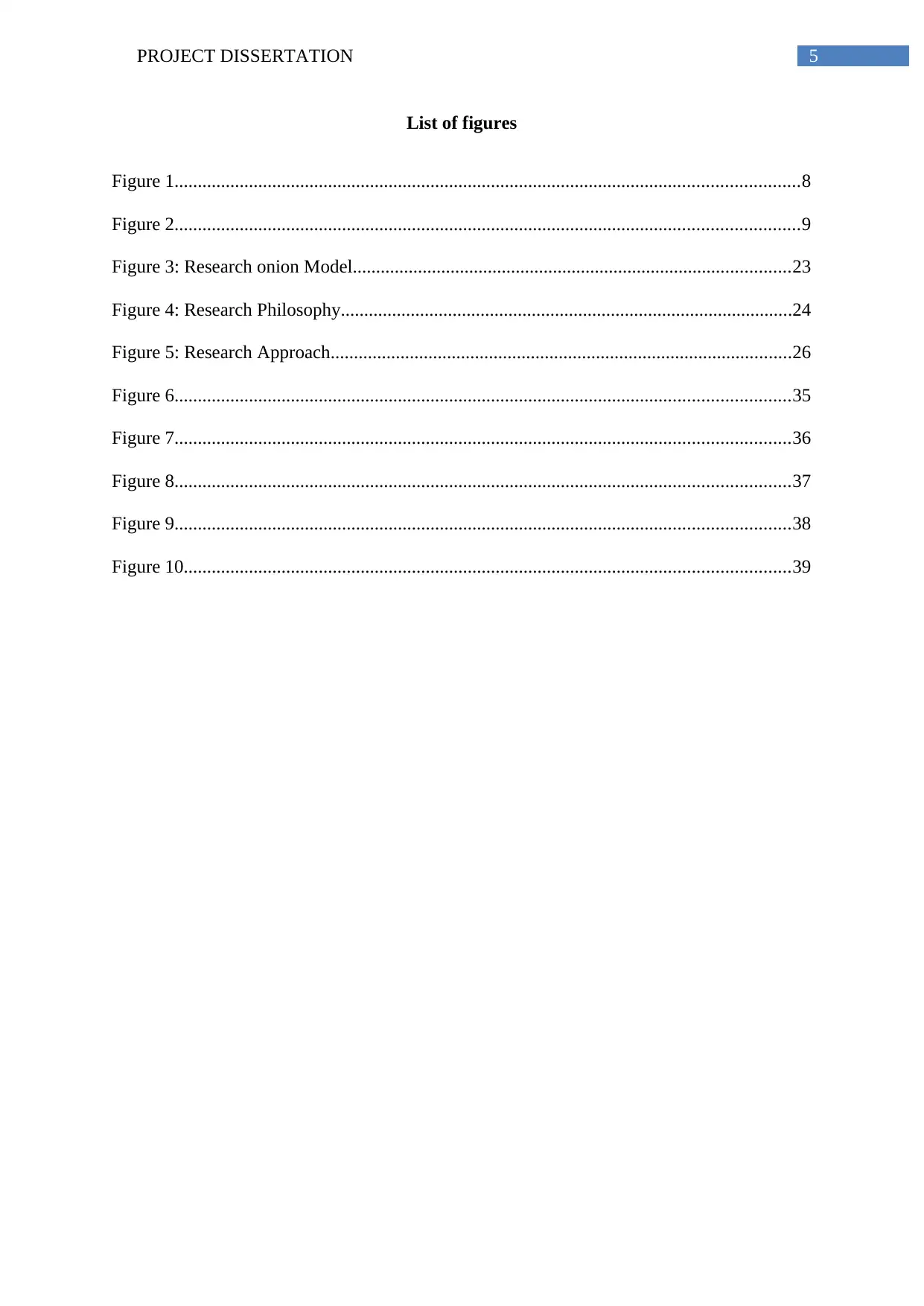
5PROJECT DISSERTATION
List of figures
Figure 1......................................................................................................................................8
Figure 2......................................................................................................................................9
Figure 3: Research onion Model..............................................................................................23
Figure 4: Research Philosophy.................................................................................................24
Figure 5: Research Approach...................................................................................................26
Figure 6....................................................................................................................................35
Figure 7....................................................................................................................................36
Figure 8....................................................................................................................................37
Figure 9....................................................................................................................................38
Figure 10..................................................................................................................................39
List of figures
Figure 1......................................................................................................................................8
Figure 2......................................................................................................................................9
Figure 3: Research onion Model..............................................................................................23
Figure 4: Research Philosophy.................................................................................................24
Figure 5: Research Approach...................................................................................................26
Figure 6....................................................................................................................................35
Figure 7....................................................................................................................................36
Figure 8....................................................................................................................................37
Figure 9....................................................................................................................................38
Figure 10..................................................................................................................................39
⊘ This is a preview!⊘
Do you want full access?
Subscribe today to unlock all pages.

Trusted by 1+ million students worldwide
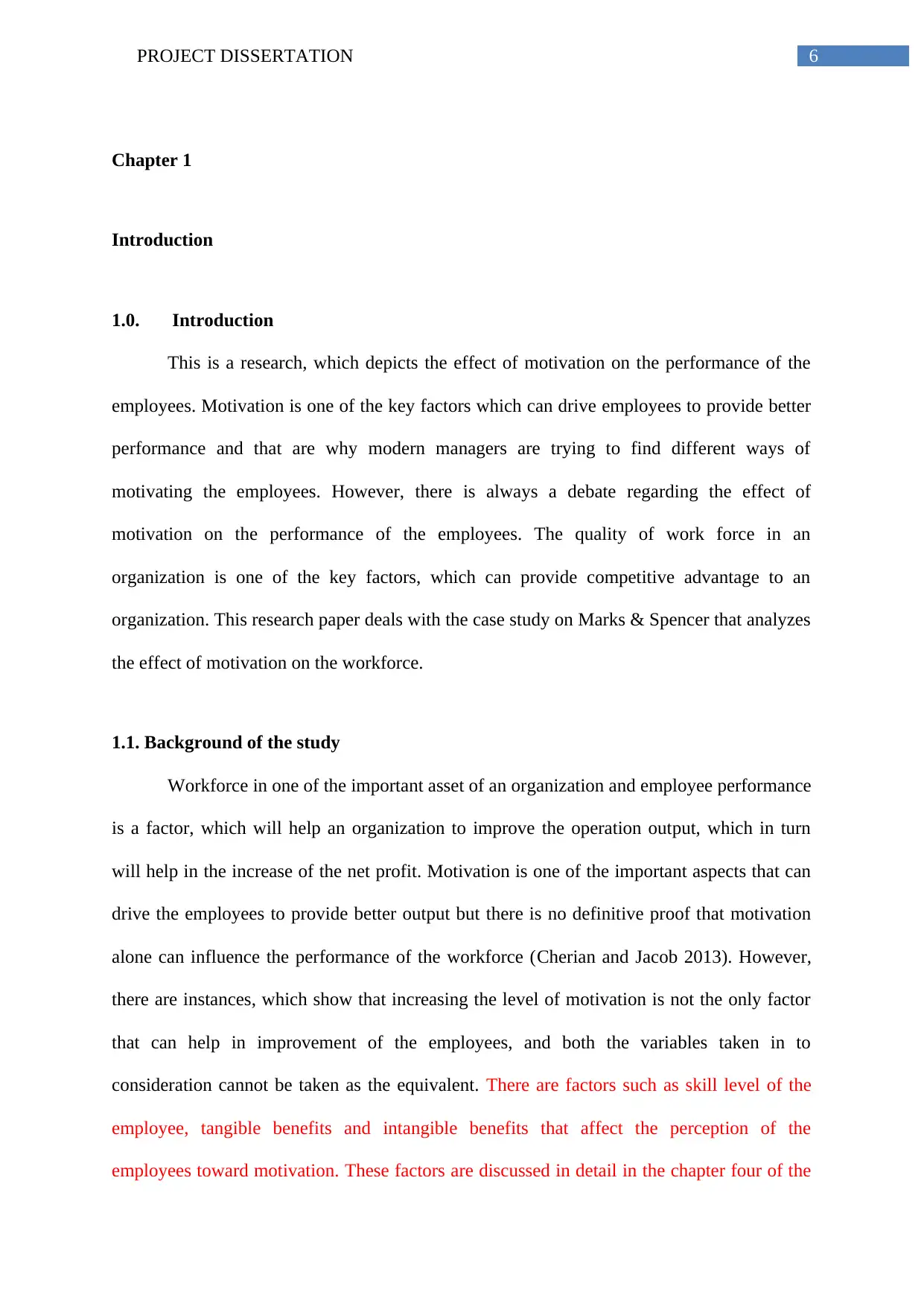
6PROJECT DISSERTATION
Chapter 1
Introduction
1.0. Introduction
This is a research, which depicts the effect of motivation on the performance of the
employees. Motivation is one of the key factors which can drive employees to provide better
performance and that are why modern managers are trying to find different ways of
motivating the employees. However, there is always a debate regarding the effect of
motivation on the performance of the employees. The quality of work force in an
organization is one of the key factors, which can provide competitive advantage to an
organization. This research paper deals with the case study on Marks & Spencer that analyzes
the effect of motivation on the workforce.
1.1. Background of the study
Workforce in one of the important asset of an organization and employee performance
is a factor, which will help an organization to improve the operation output, which in turn
will help in the increase of the net profit. Motivation is one of the important aspects that can
drive the employees to provide better output but there is no definitive proof that motivation
alone can influence the performance of the workforce (Cherian and Jacob 2013). However,
there are instances, which show that increasing the level of motivation is not the only factor
that can help in improvement of the employees, and both the variables taken in to
consideration cannot be taken as the equivalent. There are factors such as skill level of the
employee, tangible benefits and intangible benefits that affect the perception of the
employees toward motivation. These factors are discussed in detail in the chapter four of the
Chapter 1
Introduction
1.0. Introduction
This is a research, which depicts the effect of motivation on the performance of the
employees. Motivation is one of the key factors which can drive employees to provide better
performance and that are why modern managers are trying to find different ways of
motivating the employees. However, there is always a debate regarding the effect of
motivation on the performance of the employees. The quality of work force in an
organization is one of the key factors, which can provide competitive advantage to an
organization. This research paper deals with the case study on Marks & Spencer that analyzes
the effect of motivation on the workforce.
1.1. Background of the study
Workforce in one of the important asset of an organization and employee performance
is a factor, which will help an organization to improve the operation output, which in turn
will help in the increase of the net profit. Motivation is one of the important aspects that can
drive the employees to provide better output but there is no definitive proof that motivation
alone can influence the performance of the workforce (Cherian and Jacob 2013). However,
there are instances, which show that increasing the level of motivation is not the only factor
that can help in improvement of the employees, and both the variables taken in to
consideration cannot be taken as the equivalent. There are factors such as skill level of the
employee, tangible benefits and intangible benefits that affect the perception of the
employees toward motivation. These factors are discussed in detail in the chapter four of the
Paraphrase This Document
Need a fresh take? Get an instant paraphrase of this document with our AI Paraphraser
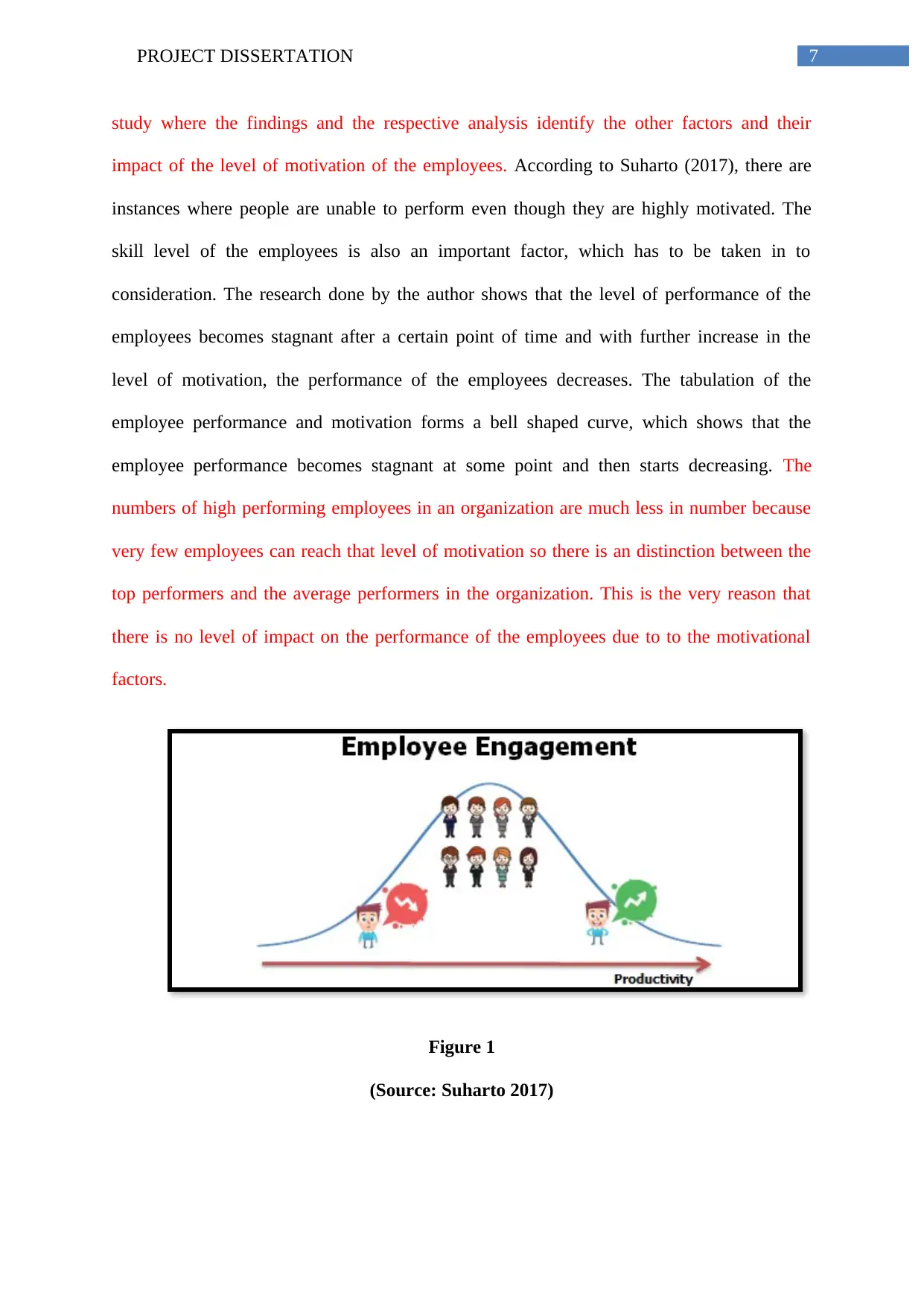
7PROJECT DISSERTATION
study where the findings and the respective analysis identify the other factors and their
impact of the level of motivation of the employees. According to Suharto (2017), there are
instances where people are unable to perform even though they are highly motivated. The
skill level of the employees is also an important factor, which has to be taken in to
consideration. The research done by the author shows that the level of performance of the
employees becomes stagnant after a certain point of time and with further increase in the
level of motivation, the performance of the employees decreases. The tabulation of the
employee performance and motivation forms a bell shaped curve, which shows that the
employee performance becomes stagnant at some point and then starts decreasing. The
numbers of high performing employees in an organization are much less in number because
very few employees can reach that level of motivation so there is an distinction between the
top performers and the average performers in the organization. This is the very reason that
there is no level of impact on the performance of the employees due to to the motivational
factors.
Figure 1
(Source: Suharto 2017)
study where the findings and the respective analysis identify the other factors and their
impact of the level of motivation of the employees. According to Suharto (2017), there are
instances where people are unable to perform even though they are highly motivated. The
skill level of the employees is also an important factor, which has to be taken in to
consideration. The research done by the author shows that the level of performance of the
employees becomes stagnant after a certain point of time and with further increase in the
level of motivation, the performance of the employees decreases. The tabulation of the
employee performance and motivation forms a bell shaped curve, which shows that the
employee performance becomes stagnant at some point and then starts decreasing. The
numbers of high performing employees in an organization are much less in number because
very few employees can reach that level of motivation so there is an distinction between the
top performers and the average performers in the organization. This is the very reason that
there is no level of impact on the performance of the employees due to to the motivational
factors.
Figure 1
(Source: Suharto 2017)
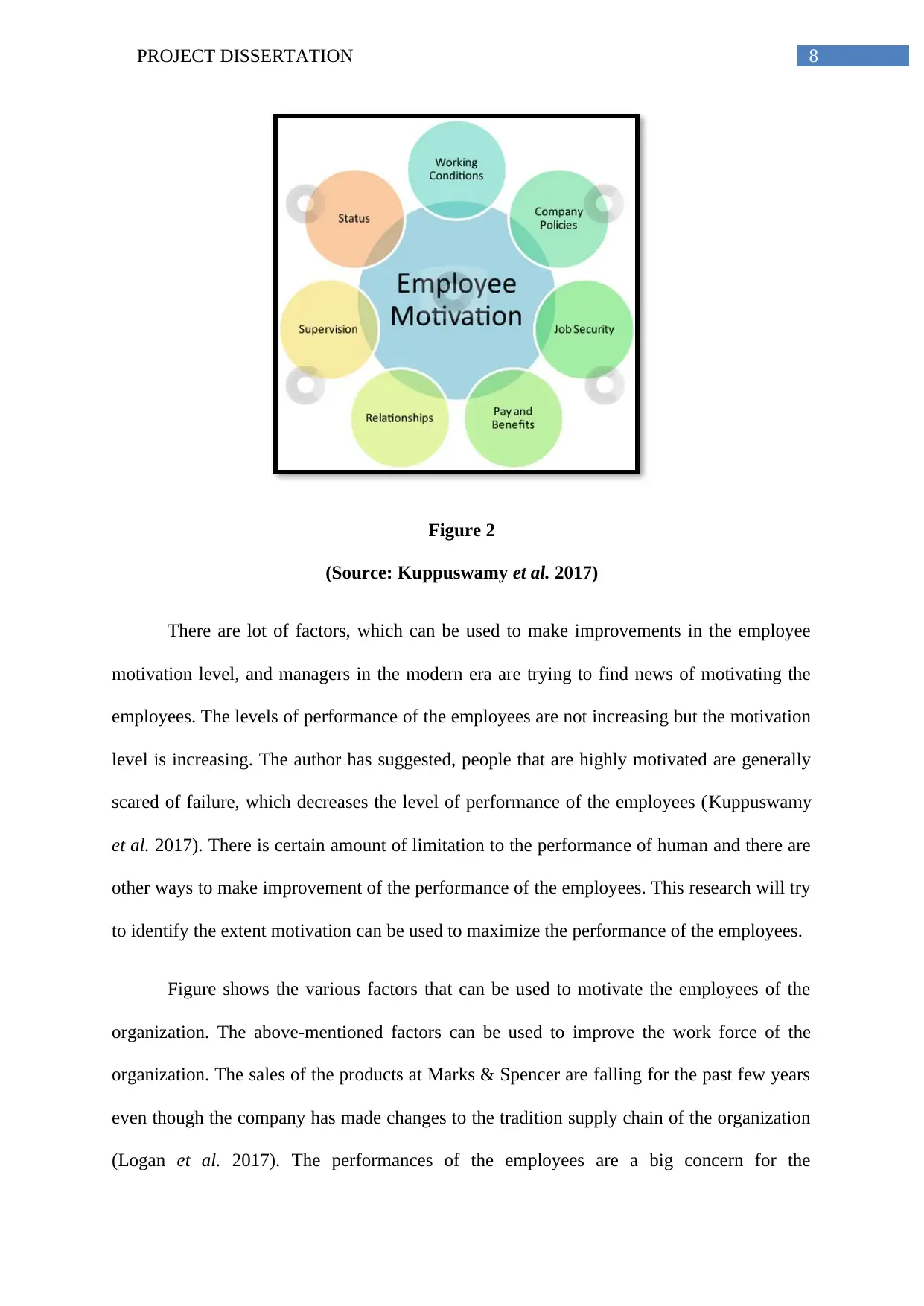
8PROJECT DISSERTATION
Figure 2
(Source: Kuppuswamy et al. 2017)
There are lot of factors, which can be used to make improvements in the employee
motivation level, and managers in the modern era are trying to find news of motivating the
employees. The levels of performance of the employees are not increasing but the motivation
level is increasing. The author has suggested, people that are highly motivated are generally
scared of failure, which decreases the level of performance of the employees (Kuppuswamy
et al. 2017). There is certain amount of limitation to the performance of human and there are
other ways to make improvement of the performance of the employees. This research will try
to identify the extent motivation can be used to maximize the performance of the employees.
Figure shows the various factors that can be used to motivate the employees of the
organization. The above-mentioned factors can be used to improve the work force of the
organization. The sales of the products at Marks & Spencer are falling for the past few years
even though the company has made changes to the tradition supply chain of the organization
(Logan et al. 2017). The performances of the employees are a big concern for the
Figure 2
(Source: Kuppuswamy et al. 2017)
There are lot of factors, which can be used to make improvements in the employee
motivation level, and managers in the modern era are trying to find news of motivating the
employees. The levels of performance of the employees are not increasing but the motivation
level is increasing. The author has suggested, people that are highly motivated are generally
scared of failure, which decreases the level of performance of the employees (Kuppuswamy
et al. 2017). There is certain amount of limitation to the performance of human and there are
other ways to make improvement of the performance of the employees. This research will try
to identify the extent motivation can be used to maximize the performance of the employees.
Figure shows the various factors that can be used to motivate the employees of the
organization. The above-mentioned factors can be used to improve the work force of the
organization. The sales of the products at Marks & Spencer are falling for the past few years
even though the company has made changes to the tradition supply chain of the organization
(Logan et al. 2017). The performances of the employees are a big concern for the
⊘ This is a preview!⊘
Do you want full access?
Subscribe today to unlock all pages.

Trusted by 1+ million students worldwide
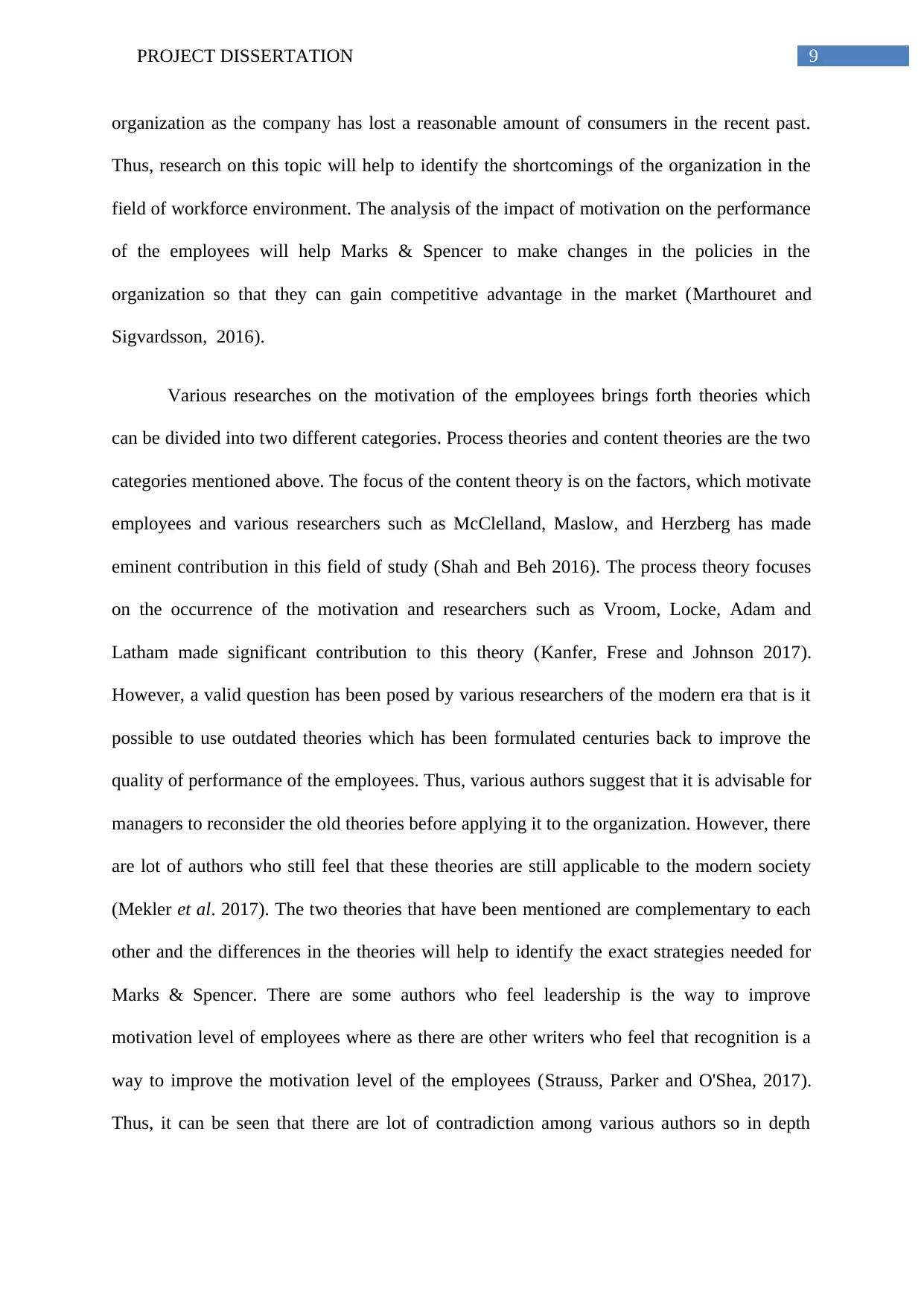
9PROJECT DISSERTATION
organization as the company has lost a reasonable amount of consumers in the recent past.
Thus, research on this topic will help to identify the shortcomings of the organization in the
field of workforce environment. The analysis of the impact of motivation on the performance
of the employees will help Marks & Spencer to make changes in the policies in the
organization so that they can gain competitive advantage in the market (Marthouret and
Sigvardsson, 2016).
Various researches on the motivation of the employees brings forth theories which
can be divided into two different categories. Process theories and content theories are the two
categories mentioned above. The focus of the content theory is on the factors, which motivate
employees and various researchers such as McClelland, Maslow, and Herzberg has made
eminent contribution in this field of study (Shah and Beh 2016). The process theory focuses
on the occurrence of the motivation and researchers such as Vroom, Locke, Adam and
Latham made significant contribution to this theory (Kanfer, Frese and Johnson 2017).
However, a valid question has been posed by various researchers of the modern era that is it
possible to use outdated theories which has been formulated centuries back to improve the
quality of performance of the employees. Thus, various authors suggest that it is advisable for
managers to reconsider the old theories before applying it to the organization. However, there
are lot of authors who still feel that these theories are still applicable to the modern society
(Mekler et al. 2017). The two theories that have been mentioned are complementary to each
other and the differences in the theories will help to identify the exact strategies needed for
Marks & Spencer. There are some authors who feel leadership is the way to improve
motivation level of employees where as there are other writers who feel that recognition is a
way to improve the motivation level of the employees (Strauss, Parker and O'Shea, 2017).
Thus, it can be seen that there are lot of contradiction among various authors so in depth
organization as the company has lost a reasonable amount of consumers in the recent past.
Thus, research on this topic will help to identify the shortcomings of the organization in the
field of workforce environment. The analysis of the impact of motivation on the performance
of the employees will help Marks & Spencer to make changes in the policies in the
organization so that they can gain competitive advantage in the market (Marthouret and
Sigvardsson, 2016).
Various researches on the motivation of the employees brings forth theories which
can be divided into two different categories. Process theories and content theories are the two
categories mentioned above. The focus of the content theory is on the factors, which motivate
employees and various researchers such as McClelland, Maslow, and Herzberg has made
eminent contribution in this field of study (Shah and Beh 2016). The process theory focuses
on the occurrence of the motivation and researchers such as Vroom, Locke, Adam and
Latham made significant contribution to this theory (Kanfer, Frese and Johnson 2017).
However, a valid question has been posed by various researchers of the modern era that is it
possible to use outdated theories which has been formulated centuries back to improve the
quality of performance of the employees. Thus, various authors suggest that it is advisable for
managers to reconsider the old theories before applying it to the organization. However, there
are lot of authors who still feel that these theories are still applicable to the modern society
(Mekler et al. 2017). The two theories that have been mentioned are complementary to each
other and the differences in the theories will help to identify the exact strategies needed for
Marks & Spencer. There are some authors who feel leadership is the way to improve
motivation level of employees where as there are other writers who feel that recognition is a
way to improve the motivation level of the employees (Strauss, Parker and O'Shea, 2017).
Thus, it can be seen that there are lot of contradiction among various authors so in depth
Paraphrase This Document
Need a fresh take? Get an instant paraphrase of this document with our AI Paraphraser
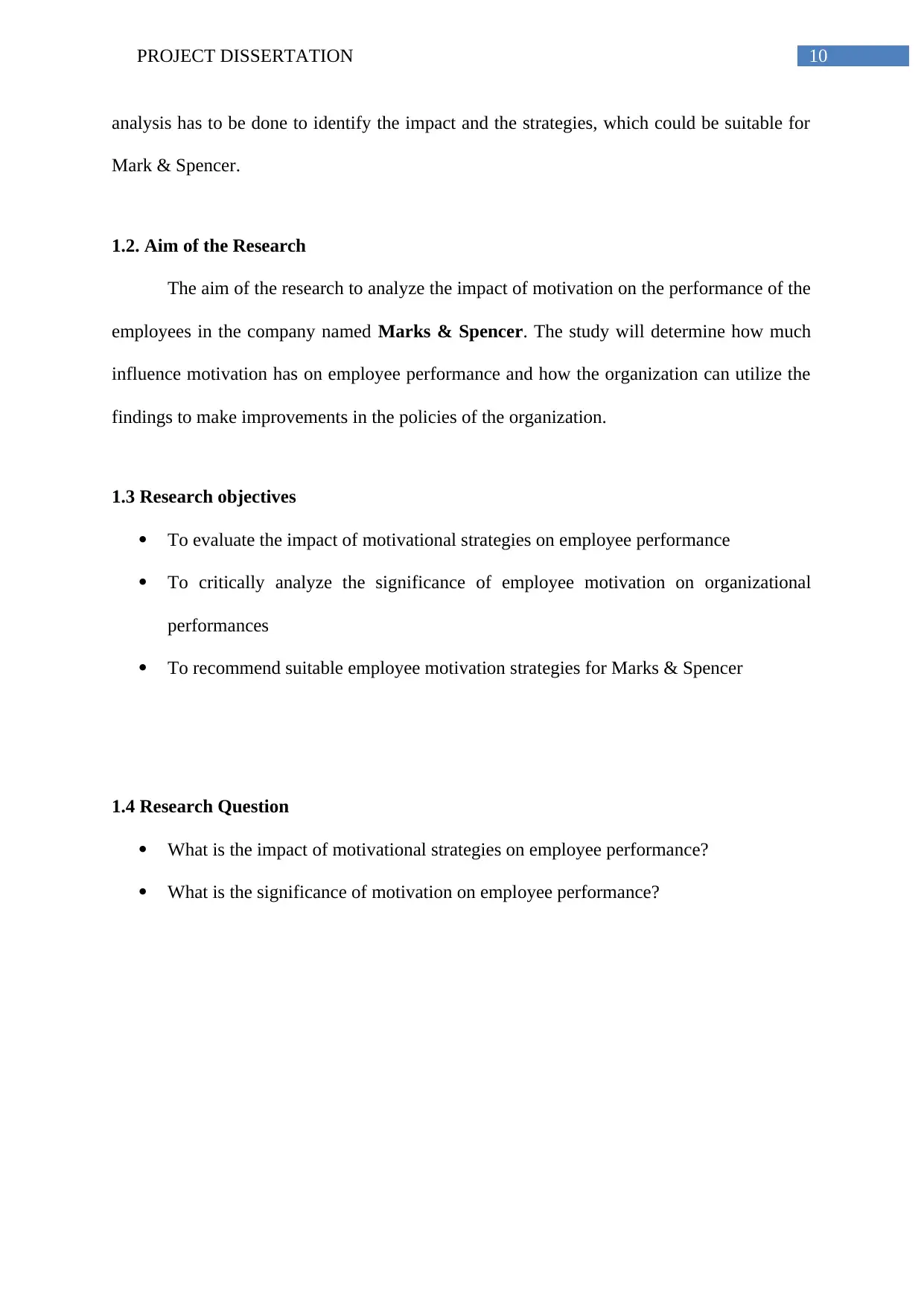
10PROJECT DISSERTATION
analysis has to be done to identify the impact and the strategies, which could be suitable for
Mark & Spencer.
1.2. Aim of the Research
The aim of the research to analyze the impact of motivation on the performance of the
employees in the company named Marks & Spencer. The study will determine how much
influence motivation has on employee performance and how the organization can utilize the
findings to make improvements in the policies of the organization.
1.3 Research objectives
To evaluate the impact of motivational strategies on employee performance
To critically analyze the significance of employee motivation on organizational
performances
To recommend suitable employee motivation strategies for Marks & Spencer
1.4 Research Question
What is the impact of motivational strategies on employee performance?
What is the significance of motivation on employee performance?
analysis has to be done to identify the impact and the strategies, which could be suitable for
Mark & Spencer.
1.2. Aim of the Research
The aim of the research to analyze the impact of motivation on the performance of the
employees in the company named Marks & Spencer. The study will determine how much
influence motivation has on employee performance and how the organization can utilize the
findings to make improvements in the policies of the organization.
1.3 Research objectives
To evaluate the impact of motivational strategies on employee performance
To critically analyze the significance of employee motivation on organizational
performances
To recommend suitable employee motivation strategies for Marks & Spencer
1.4 Research Question
What is the impact of motivational strategies on employee performance?
What is the significance of motivation on employee performance?
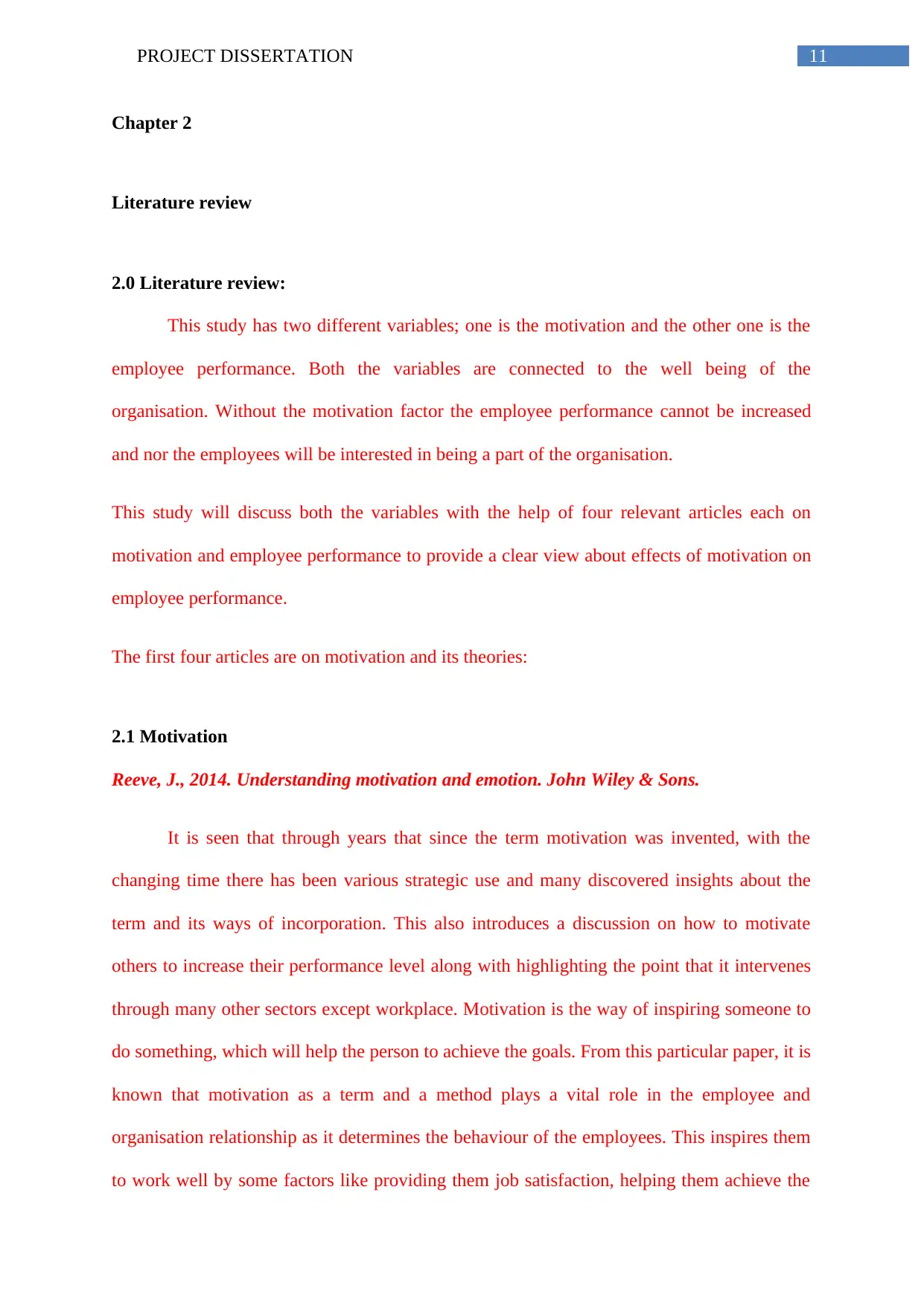
11PROJECT DISSERTATION
Chapter 2
Literature review
2.0 Literature review:
This study has two different variables; one is the motivation and the other one is the
employee performance. Both the variables are connected to the well being of the
organisation. Without the motivation factor the employee performance cannot be increased
and nor the employees will be interested in being a part of the organisation.
This study will discuss both the variables with the help of four relevant articles each on
motivation and employee performance to provide a clear view about effects of motivation on
employee performance.
The first four articles are on motivation and its theories:
2.1 Motivation
Reeve, J., 2014. Understanding motivation and emotion. John Wiley & Sons.
It is seen that through years that since the term motivation was invented, with the
changing time there has been various strategic use and many discovered insights about the
term and its ways of incorporation. This also introduces a discussion on how to motivate
others to increase their performance level along with highlighting the point that it intervenes
through many other sectors except workplace. Motivation is the way of inspiring someone to
do something, which will help the person to achieve the goals. From this particular paper, it is
known that motivation as a term and a method plays a vital role in the employee and
organisation relationship as it determines the behaviour of the employees. This inspires them
to work well by some factors like providing them job satisfaction, helping them achieve the
Chapter 2
Literature review
2.0 Literature review:
This study has two different variables; one is the motivation and the other one is the
employee performance. Both the variables are connected to the well being of the
organisation. Without the motivation factor the employee performance cannot be increased
and nor the employees will be interested in being a part of the organisation.
This study will discuss both the variables with the help of four relevant articles each on
motivation and employee performance to provide a clear view about effects of motivation on
employee performance.
The first four articles are on motivation and its theories:
2.1 Motivation
Reeve, J., 2014. Understanding motivation and emotion. John Wiley & Sons.
It is seen that through years that since the term motivation was invented, with the
changing time there has been various strategic use and many discovered insights about the
term and its ways of incorporation. This also introduces a discussion on how to motivate
others to increase their performance level along with highlighting the point that it intervenes
through many other sectors except workplace. Motivation is the way of inspiring someone to
do something, which will help the person to achieve the goals. From this particular paper, it is
known that motivation as a term and a method plays a vital role in the employee and
organisation relationship as it determines the behaviour of the employees. This inspires them
to work well by some factors like providing them job satisfaction, helping them achieve the
⊘ This is a preview!⊘
Do you want full access?
Subscribe today to unlock all pages.

Trusted by 1+ million students worldwide
1 out of 52
Related Documents
Your All-in-One AI-Powered Toolkit for Academic Success.
+13062052269
info@desklib.com
Available 24*7 on WhatsApp / Email
![[object Object]](/_next/static/media/star-bottom.7253800d.svg)
Unlock your academic potential
Copyright © 2020–2025 A2Z Services. All Rights Reserved. Developed and managed by ZUCOL.





